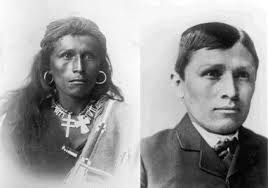Thousands of girls and boys were raped and tortured, and many were murdered, in Canada's aboriginal boarding schools. In Canada, up until 1985, Christian churches ran around 100 boarding schools for aboriginal children. Between 100,000 and 200,000 children were forced to attend these boarding schools. Reportedly, around 50,000 aboriginal children died in these schools. Documents show a death rate of 50%.
“The report says church officials killed children by beating, poisoning, electric shock, starvation, prolonged exposure to sub-zero cold while naked, and medical experimentation, including the removal of organs and radiation exposure.” […] Children also suffered forced sterilization, medical experimentation, starvation, rape as well as various other forms of sexual abuse, and murder….. Some spoke of young girls becoming pregnant as a result of rape, or nuns becoming pregnant after sexually abusing boys…’”

In British Columbia, the first Indian Residential School was established in 1861 at Mission and was operated by the Roman Catholic Church. It would also become the last operating school in the province, finally closing in 1984.
Elsewhere in Canada, Indian Residential Schools dotted the nation. Around 130 residential schools herded aboriginal children like cattle to teach them how to become productive members of “white society.” The former Grand Chief of the Assembly of First Nations, Matthew Coon Come, calls this system genocide.
“Basically, the goal was to take the Indian out of the Indian,” he says.
This bold state-funded enterprise was for the most part carried out in western Canada with tremendous bureaucratic and missionary zeal for over a century. Christian ideology insisted it was acceptable to “obliterate” indigenous peoples’ distinct cultural “habits and associations” while simultaneously fostering the colonial “process of nation building.”
“After a lifetime of beatings, going hungry, standing in a corridor on one leg, and walking in the snow with no shoes for speaking Inuvialuktun, and having a heavy, stinging paste rubbed on my face, which they did to stop us from expressing our Eskimo custom of raising our eyebrows for ‘yes’ and wrinkling our noses for ‘no’, I soon lost the ability to speak my mother tongue. When a language dies, the world it was generated from is broken down too.”
Mary Carpenter 1995
Department of Indian Affairs’ policy that aboriginal children must not be educated “above the possibilities of their station”, were upheld. As such, the schools’ curriculum included moral training (through physical labour), academic training (although many teachers were insufficiently educated) and industrial training (for farming and menial jobs). Engaged in the classroom for only half a day, the children were responsible for the complete maintenance (cooking, cleaning, laundry, grounds keeping, farming, etc.) of the school for the remainder of their day. Grade three was the acceptable standard of education.
Psychological and emotional abuses were constant: shaming by public beatings of naked children, vilification of native culture, constant racism, public strip and genital searches, withholding presents and letters from family, locking children in closets and cages, segregation of sexes, separation of brothers and sisters, proscription of native languages and spirituality. In addition, the schools were places of profound physical and sexual violence: sexual assaults, forced abortions of staff-impregnated girls, needles inserted into tongues for speaking a native language, burning, scalding, beating until unconscious and/or inflicting permanent injury.
They also endured electrical shock, force-feeding of their own vomit when sick, exposure to freezing outside temperatures, withholding of medical attention, shaved heads (a cultural and social violation), starvation (as punishment), forced labour in unsafe work situations, intentional contamination with diseased blankets, insufficient food for basic nutrition and/or spoiled food. Estimates suggest that as many as 60% of the students died (due to illness, beatings, attempts to escape, or suicide) while in the schools.


“The Sisters didn’t treat me good. They gave me rotten food to eat and punished me for not eating it. I was locked in a room, fed bread and water and beaten with a strap, sometimes on the face, and sometimes [they] took my clothes off and beat me. This is the reason I ran away.”
Christine Haines, St. Joseph’s 1995
Despite having signed the United Nations genocide convention 40 years before the last residential school closed, Canada continued to commit acts of genocide:
“with the intent to destroy in whole or part, a national, ethnical, racial or religious group, as such: … (e) forcibly transferring children of the group to another group.” (United Nations Convention on Genocide, 1946)
In 1948, despite a joint (House of Commons and Senate) committee recommendation that the schools be abolished, the churches’ vigourous lobbying for the system to continue and the fact that it was being used as a social welfare placement kept the schools alive for 40 more years. By the 1970s, when the Native Indian Brotherhood called for native control of native education, the federal government had begun to wind down the residential school system.
Today, approximately 90,000 survivors in their thirties and older are trying to understand, heal from, and move beyond this devastating experience. About 14% are involved in some form of litigation while the other 86% are living out their lives as best they can.
“What I remember of that time was passing Muncho Lake on the trip up north, [to residential school] and imagining I was drowning. That is where I left my life; I drowned in Muncho Lake. I haven’t forgiven my parents to this day because…they weren’t there to protect me.”
Survivor, Kamloops School 2000
It is generally accepted that the forced removal of children from their families was devastating for Aboriginal individuals, families, communities and cultures. This is regularly being confirmed by researchers today.
First Nation communities experience higher rates of violence: physical, domestic abuse (3x higher than mainstream society); sexual abuse: rape, incest, etc. (4-6x higher); lack of family and community cohesion; suicide (6x higher); addictions: drugs, alcohol, food; health problems: diabetes (3x higher), heart disease, obesity; poverty; unemployment; illiteracy; high school dropout (63% do not graduate); despair; hopelessness; and more.




No comments:
Post a Comment